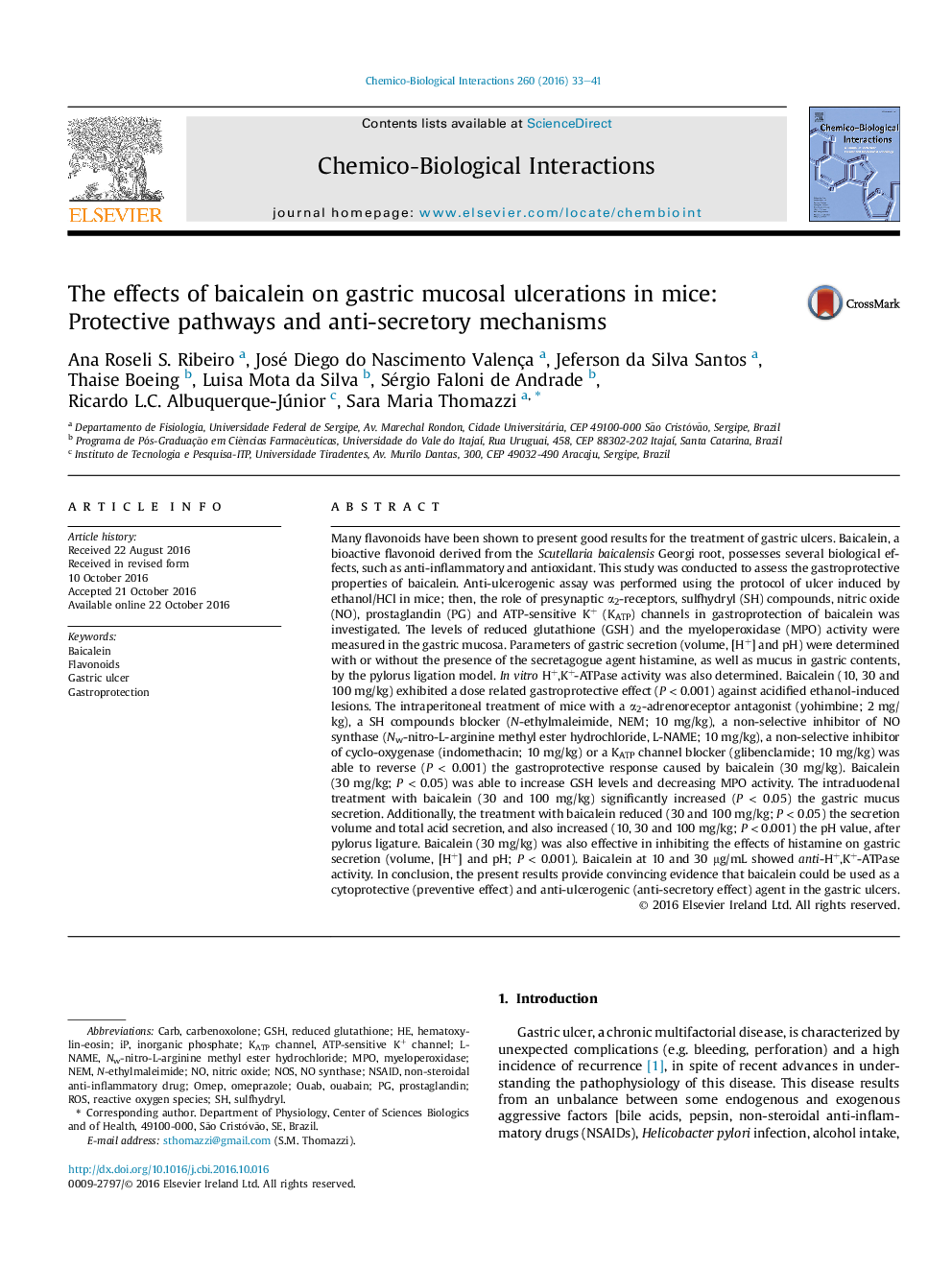| Article ID | Journal | Published Year | Pages | File Type |
|---|---|---|---|---|
| 5559393 | Chemico-Biological Interactions | 2016 | 9 Pages |
Abstract
Many flavonoids have been shown to present good results for the treatment of gastric ulcers. Baicalein, a bioactive flavonoid derived from the Scutellaria baicalensis Georgi root, possesses several biological effects, such as anti-inflammatory and antioxidant. This study was conducted to assess the gastroprotective properties of baicalein. Anti-ulcerogenic assay was performed using the protocol of ulcer induced by ethanol/HCl in mice; then, the role of presynaptic α2-receptors, sulfhydryl (SH) compounds, nitric oxide (NO), prostaglandin (PG) and ATP-sensitive K+ (KATP) channels in gastroprotection of baicalein was investigated. The levels of reduced glutathione (GSH) and the myeloperoxidase (MPO) activity were measured in the gastric mucosa. Parameters of gastric secretion (volume, [H+] and pH) were determined with or without the presence of the secretagogue agent histamine, as well as mucus in gastric contents, by the pylorus ligation model. In vitro H+,K+-ATPase activity was also determined. Baicalein (10, 30 and 100 mg/kg) exhibited a dose related gastroprotective effect (P < 0.001) against acidified ethanol-induced lesions. The intraperitoneal treatment of mice with a α2-adrenoreceptor antagonist (yohimbine; 2 mg/kg), a SH compounds blocker (N-ethylmaleimide, NEM; 10 mg/kg), a non-selective inhibitor of NO synthase (Nw-nitro-L-arginine methyl ester hydrochloride, L-NAME; 10 mg/kg), a non-selective inhibitor of cyclo-oxygenase (indomethacin; 10 mg/kg) or a KATP channel blocker (glibenclamide; 10 mg/kg) was able to reverse (P < 0.001) the gastroprotective response caused by baicalein (30 mg/kg). Baicalein (30 mg/kg; P < 0.05) was able to increase GSH levels and decreasing MPO activity. The intraduodenal treatment with baicalein (30 and 100 mg/kg) significantly increased (P < 0.05) the gastric mucus secretion. Additionally, the treatment with baicalein reduced (30 and 100 mg/kg; P < 0.05) the secretion volume and total acid secretion, and also increased (10, 30 and 100 mg/kg; P < 0.001) the pH value, after pylorus ligature. Baicalein (30 mg/kg) was also effective in inhibiting the effects of histamine on gastric secretion (volume, [H+] and pH; P < 0.001). Baicalein at 10 and 30 μg/mL showed anti-H+,K+-ATPase activity. In conclusion, the present results provide convincing evidence that baicalein could be used as a cytoprotective (preventive effect) and anti-ulcerogenic (anti-secretory effect) agent in the gastric ulcers.
Keywords
NO synthaseCARBNOSbaicaleinNSAIDGSHN-ethylmaleimideMPOl-NAMEROSOmeprazoleOuabainGastroprotectionGastric ulcersulfhydrylNon-steroidal anti-inflammatory druginorganic phosphateFlavonoidsmyeloperoxidaseNEMNitric oxidehematoxylin-eosinprostaglandincarbenoxoloneATP-sensitive K+ channelKATP channelreduced glutathioneReactive oxygen species
Related Topics
Life Sciences
Environmental Science
Health, Toxicology and Mutagenesis
Authors
Ana Roseli S. Ribeiro, José Diego do Nascimento Valença, Jeferson da Silva Santos, Thaise Boeing, Luisa Mota da Silva, Sérgio Faloni de Andrade, Ricardo L.C. Albuquerque-Júnior, Sara Maria Thomazzi,
